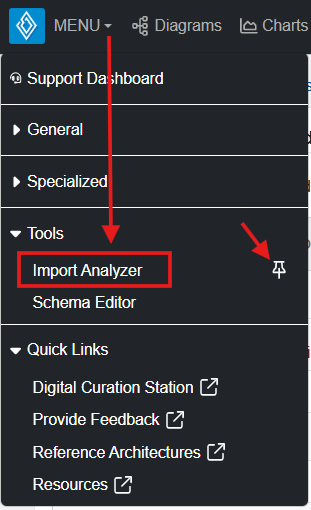Import Analyzer Overview
Import information through Innoslate's Import Analyzer.
The key to importing information into Innoslate is the import tool called ‘Import Analyzer.’ This tool provides separate tabs for each type of file with steps to guide users through the process of successfully importing their data from that file type.

Figure 1: Import Analyzer Tabs highlighted
Innoslate's ‘Import Analyzer’ is designed to be able to import the following file types:
- Microsoft Word (.docx)
- Innoslate (.xml/.inno/.json)
- Microsoft Excel (.csv)
- Plain Text (.txt)
- UML/SysML (.xmi)
- Reqif (.reqif)
Navigating to Import Analyzer
- Find the ‘MENU’ drop-down, located on the top left of the navigation bar.
- Find the Tools category and select ‘Import Analyzer’.
-
For quick and frequent access, consider pinning the Import Analyzer link to your top toolbar.
-

Figure 1: Import Analyzer on Menu Bar in Innoslate
Available Import Functions
Below, you will find helpful links to facilitate the download of the appropriate files corresponding to your version of Innoslate.
| Function | Description |
|---|---|
| Importing Microsoft Word (.docx) Files | You can import a Microsoft Word (.docx) file into Innoslate. |
| Importing Microsoft Excel (.csv) Files | You can import a Microsoft Excel (.csv) file into Innoslate. |
| Importing an Innoslate Export (.inno, .xml, .json) Files | You can import an Innoslate Export (.inno, .xml, .json) file into Innoslate. |
| Importing Plain Text (.txt) Files | You can import Plain Text (.txt) files into Innoslate. |
| Importing UML/SysML (.xmi) Files | You can import UML/SysML (.xmi) file into Innoslate. |
| Importing a ReqIF (.reqif) File | You can import a ReqIF (.reqif) file into Innoslate. |
To continue learning about Import Analyzer, Click Here.
(Next Article: Importing Microsoft Word (.docx) Files)
